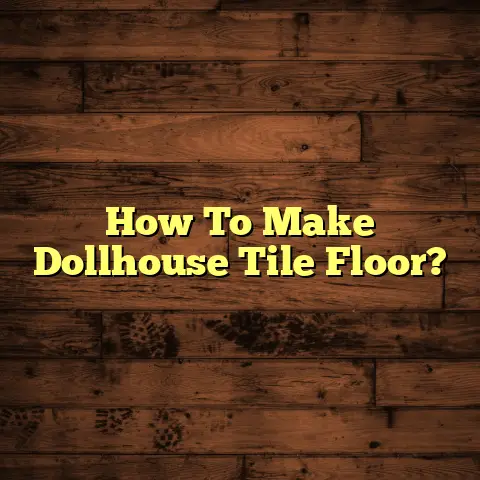Self-Adhesive Vinyl Tiles: Pros & Cons? (1 Mistake?)
Did you know that the flooring you choose can dramatically influence the overall ambiance of your home?
Yet, many homeowners overlook the impact of self-adhesive vinyl tiles!
I’ve seen it time and time again.
Choosing the right flooring is a big deal.
These tiles seem like a quick and easy fix.
But are they really?
Let’s dive in and see if these tiles are a perfect fit for you.
Why Are Self-Adhesive Vinyl Tiles So Popular?
Self-adhesive vinyl tiles have exploded in popularity.
I’ve seen them pop up in countless homes and even some light commercial spaces.
Their appeal is simple: they promise easy installation and serious affordability.
But does that promise hold up?
I’m here to give you the inside scoop.
Section 1: What Exactly Are Self-Adhesive Vinyl Tiles?
Let’s break down what these tiles are all about.
They’re essentially vinyl tiles with a pre-applied adhesive backing.
Think of it like a giant sticker for your floor.
The Anatomy of a Vinyl Tile
These tiles are typically made from several layers:
- A base layer: Usually made of PVC (polyvinyl chloride).
- A printed decorative layer: This is where the style comes in.
- A protective wear layer: This guards against scratches and scuffs.
- An adhesive backing: Covered by a release liner that you peel off.
The manufacturing process involves layering these materials.
Heat and pressure bond them together.
The result is a flexible, water-resistant tile that’s ready to stick.
Styles, Colors, and Patterns Galore
One of the biggest draws of self-adhesive vinyl tiles is their versatility.
You can find them in a mind-boggling array of styles.
Want the look of hardwood without the hefty price tag?
There are vinyl tiles that mimic wood grain almost perfectly.
Dreaming of a sleek stone floor but dreading the installation?
Vinyl tiles can replicate marble, slate, and even ceramic.
From classic patterns to modern designs, the options are endless.
This makes them suitable for nearly any room and décor style.
I’ve seen them transform everything from drab basements to chic kitchens.
Applications: Where Do They Shine?
These tiles are designed for various applications.
They work in both residential and light commercial settings.
Think kitchens, bathrooms, laundry rooms, basements, and even offices.
Their water resistance makes them ideal for moisture-prone areas.
Their ease of installation makes them attractive for DIY projects.
However, I always caution people to consider the level of traffic.
Higher traffic areas may require a more durable flooring solution.
Section 2: The Allure: Pros of Self-Adhesive Vinyl Tiles
Let’s get into the good stuff.
Why are these tiles so appealing?
DIY Dream: Ease of Installation
This is the big one.
Self-adhesive vinyl tiles are designed for easy installation.
You don’t need special tools or professional expertise.
Just peel off the backing and stick them to a clean, level surface.
I’ve seen complete novices transform a room in a single afternoon.
This is a huge advantage for DIY enthusiasts.
It saves you money on professional installation costs.
Wallet-Friendly Flooring: Cost-Effectiveness
Compared to other flooring options, self-adhesive vinyl tiles are incredibly affordable.
You can often find them for a fraction of the cost of hardwood, laminate, or ceramic tile.
But the savings don’t stop there.
Because you can install them yourself, you avoid labor costs.
Plus, their low maintenance requirements contribute to long-term savings.
I’ve helped homeowners revamp their entire homes on a tight budget using these tiles.
Aesthetic Chameleon: Variety of Designs
As I mentioned earlier, the design options are vast.
You can achieve almost any look you desire.
Want a rustic farmhouse feel?
Go for wood-look vinyl tiles with a distressed finish.
Prefer a modern, minimalist vibe?
Opt for sleek gray tiles that mimic concrete.
The possibilities are truly endless.
This allows you to customize your space to your exact taste without breaking the bank.
Water Warriors: Water Resistance
This is a major selling point for kitchens and bathrooms.
Self-adhesive vinyl tiles are inherently water-resistant.
They won’t warp, swell, or rot when exposed to moisture.
This makes them a practical choice for areas prone to spills and splashes.
However, it’s important to note that they’re not completely waterproof.
Standing water can still seep through the seams.
So, prompt cleanup is always recommended.
Effortless Upkeep: Low Maintenance
Busy households rejoice!
Self-adhesive vinyl tiles are incredibly easy to clean and maintain.
A simple sweep or mop is usually all it takes to keep them looking their best.
They’re also resistant to stains and spills.
This makes them a practical choice for families with kids and pets.
I always recommend using a pH-neutral cleaner to avoid damaging the surface.
Section 3: The Dark Side: Cons of Self-Adhesive Vinyl Tiles
Now for the not-so-glamorous side of things.
Let’s talk about the drawbacks of self-adhesive vinyl tiles.
Wear and Tear Worries: Durability Concerns
While they’re tough, they’re not indestructible.
Compared to hardwood or ceramic tile, self-adhesive vinyl tiles are less durable.
They can be susceptible to scratches, dents, and tears.
High-traffic areas may show wear and tear more quickly.
I’ve seen tiles in busy hallways start to peel or crack within a few years.
The lifespan depends heavily on the quality of the tile and the amount of traffic.
Eco-Footprint: Environmental Impact
Vinyl production isn’t exactly eco-friendly.
PVC, the main component of vinyl tiles, is a petroleum-based product.
The manufacturing process can release harmful chemicals into the environment.
And disposing of vinyl tiles can be problematic.
They’re not biodegradable and can contribute to landfill waste.
However, some manufacturers are now offering recycled vinyl options.
These are a more sustainable choice.
Time Ticking: Limited Lifespan
Don’t expect these tiles to last a lifetime.
The average lifespan of self-adhesive vinyl tiles is typically 5 to 10 years.
This can vary depending on the quality of the tile, the installation, and the amount of traffic.
In comparison, hardwood floors can last for decades with proper care.
Ceramic tile can last even longer.
So, if you’re looking for a long-term flooring solution, these tiles may not be the best choice.
Installation Nightmares: Installation Mistakes
While they’re designed for easy installation, mistakes can happen.
And these mistakes can lead to big problems down the road.
Improper surface preparation is a common culprit.
If the subfloor isn’t clean, level, and dry, the tiles won’t adhere properly.
Misalignment is another issue.
If you don’t align the tiles correctly, you’ll end up with crooked lines and gaps.
These mistakes can lead to peeling, bubbling, and an overall unprofessional look.
The Dreaded Peel: Potential for Peeling
This is perhaps the biggest concern with self-adhesive vinyl tiles.
Improper handling or exposure to moisture can cause the adhesive to fail.
This can lead to peeling, which is not only unsightly but also a tripping hazard.
I’ve seen entire floors come unglued due to moisture problems.
To prevent peeling, it’s crucial to prepare the surface properly.
Also, avoid using these tiles in areas with excessive moisture.
Section 4: The One Common Mistake That Can Ruin Your Floor
Okay, let’s get to the heart of the matter.
In my experience, the single most common mistake homeowners make when installing self-adhesive vinyl tiles is…
Skipping Proper Surface Preparation.
I cannot stress this enough.
This seemingly simple step is absolutely crucial for a successful installation.
Why This Mistake Happens
Homeowners often underestimate the importance of surface preparation.
They see the “self-adhesive” label and assume they can just slap the tiles down.
They might skip cleaning the floor thoroughly.
Or they might not bother to level out any imperfections.
Sometimes, they think a quick sweep is enough.
But trust me, it’s not.
The Consequences of Neglecting Surface Prep
When you skip proper surface preparation, you’re setting yourself up for failure.
Here’s what can happen:
- Poor Adhesion: The tiles won’t stick properly to a dirty or uneven surface.
- Peeling: Over time, the tiles will start to peel up, especially around the edges.
- Bubbling: Air pockets can get trapped under the tiles, causing them to bubble.
- Uneven Surface: Any imperfections in the subfloor will show through the tiles.
- Reduced Lifespan: The flooring won’t last as long as it should.
A Case Study: The Basement Disaster
I once worked with a homeowner who had installed self-adhesive vinyl tiles in his basement.
He was thrilled with how easy the installation was.
But within a few months, the tiles started to peel up.
It turned out he had skipped the crucial step of sealing the concrete floor.
Moisture from the ground was seeping through the concrete.
This compromised the adhesive.
He ended up having to remove all the tiles and start over.
This time, he hired me to do the job.
I made sure the floor was properly sealed and leveled before installing new tiles.
The result was a beautiful, long-lasting floor.
How to Avoid This Mistake
Here’s my advice for proper surface preparation:
- Clean the Floor Thoroughly: Use a degreasing cleaner to remove any dirt, grease, or grime.
- Level the Surface: Fill in any cracks or holes with a leveling compound.
- Sand the Surface: Use a sander to smooth out any rough spots.
- Seal the Surface (if necessary): If you’re installing over concrete, seal it to prevent moisture from seeping through.
- Let It Dry: Allow the surface to dry completely before installing the tiles.
By taking the time to prepare the surface properly, you can ensure a successful and long-lasting installation.
Section 5: The Final Verdict
So, are self-adhesive vinyl tiles a dream or a disaster?
The answer, as with most things, is it depends.
Weighing the Pros and Cons
They offer undeniable advantages:
- Easy installation
- Affordability
- Variety of designs
- Water resistance
- Low maintenance
But they also have drawbacks:
- Durability concerns
- Environmental impact
- Limited lifespan
- Potential for peeling
Consider Your Needs and Circumstances
Before making a decision, consider your own needs and circumstances.
Are you looking for a quick and affordable flooring solution for a low-traffic area?
Self-adhesive vinyl tiles might be a good choice.
Do you need a durable, long-lasting floor for a high-traffic area?
You might want to consider other options.
Making an Informed Choice
Choosing the right flooring is a big decision.
It can impact the look, feel, and value of your home.
By understanding the pros and cons of self-adhesive vinyl tiles, you can make an informed choice that’s right for you.
Remember that opening question?
Did you know that the flooring you choose can dramatically influence the overall ambiance of your home?
Now you do.
And hopefully, you’re now better equipped to make the right choice for your space.
Happy flooring!





